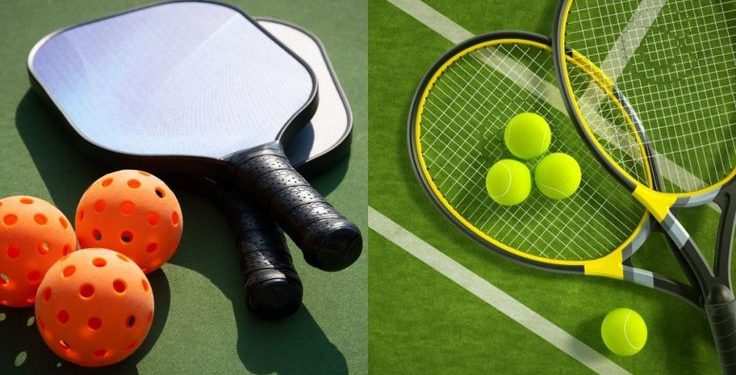Pickleball vs Tennis
The Main Difference Between Pickleball vs Tennis is the court size, equipment, and gameplay. Tennis vs Pickleball, though sometimes mistaken for each other, are distinct sports with key differences in their:
Court size: Pickleball courts are significantly smaller than tennis courts. A tennis court is roughly four times the size of a pickleball court, making pickleball a more compact and potentially easier-to-manage playing area.
Equipment: Pickleball uses solid-faced paddles and a plastic ball with holes, while tennis utilizes stringed rackets and a heavier, felt-covered ball. These differences lead to distinct playing styles, with pickleball emphasizing control and strategy, and tennis requiring more power and athleticism.
Rules: Scoring and serving differ between the two. Tennis uses a complex scoring system (15, 30, 40), while pickleball simply counts points up to 11 (with a 2-point lead needed to win). Additionally, tennis allows overhand serves, while pickleball mandates underhand serves.
Playing style: Compared to the powerful strokes and court coverage required in tennis, pickleball emphasizes finesse and quick volleys near the net due to the smaller court size. This makes pickleball potentially easier to pick up for beginners and less physically demanding overall. Choosing proper court footwear
Here’s a table summarizing the key differences:
Feature Pickleball Tennis
Court size Smaller Larger
Equipment Paddles, plastic ball Rackets, felt ball
Serving Underhand only Overhand or underhand
Scoring Up to 11 (win by 2) 15, 30, 40 system
Playing style Control, volleys Power, athleticism
Pickleball vs Tennis Court
Pickleball and tennis are both paddle sports, but they have some key differences, especially when it comes to the court they are played on.
Size:
- Pickleball: A pickleball court is much smaller than a tennis court. It is 44 feet long and 20 feet wide, about the same size as a badminton court. You can actually fit four pickleball courts on a standard tennis court!

- Tennis: A tennis court is much larger, measuring 120 feet long and 60 feet wide. It is also divided into separate areas for singles and doubles play. Tennis shoe suitability

Netting:
- Pickleball: The net on a pickleball court is the same height at the sides (36 inches) as a tennis court, but it dips down to 34 inches in the center. Pickleball court capacity
- Tennis: The net on a tennis court is 3 feet high at the sides and dips down to 2 feet 6 inches in the center.
Other differences:
- Volley zone: Pickleball has a “no-volley zone” called the “kitchen” that extends seven feet from the net on both sides. Volleying (hitting the ball before it bounces) is not allowed in the kitchen. Tennis has no such restriction.
- Surface: Pickleball is typically played on a hard court, while tennis can be played on hard courts, grass courts, or clay courts.
Pickleball vs Tennis Net Height
Pickleball and tennis nets have different heights, which can affect gameplay in each sport:
Pickleball Net:
- Height: 36 inches at the posts and 34 inches at the center.
- Reasoning: The lighter, slower-bouncing pickleball doesn’t require a high net for effective play.
Tennis Net:
- Height: 42 inches at the posts and 36 inches at the center.
- Reasoning: The faster, higher-bouncing tennis ball necessitates a taller net for challenging gameplay.
The key difference between pickleball and tennis lies in their net heights:
- Pickleball: The net is 36 inches tall at the side posts and 34 inches at the center strap.
- Tennis: The net is 42 inches tall at the side posts and 36 inches at the center strap.
So, tennis nets are 6 inches taller at the posts and have a slightly smaller dip in the middle compared to pickleball nets.
This difference is due to the varying bounce characteristics of the balls used in each sport:
Here’s a table summarizing the key differences:
Feature Pickleball Net Tennis Net
Height at Posts 36 inches 42 inches
Height at Center 34 inches 36 inches
Reason for Height Slower bounce Faster bounce
This difference in height contributes to the distinct gameplay styles of each sport. The lower pickleball net allows for more volleying and softer shots, while the higher tennis net encourages powerful serves and groundstrokes.
Pickleball vs Tennis Ball Size
While both pickleballs and tennis balls are roughly the same color (usually fluorescent yellow), their size differs:
- Pickleball: Diameter of 2.874 inches (7.30 cm) to 2.972 inches (7.55 cm). master pickleball tennis court play
- Tennis: Diameter of 2.575 inches (6.54 cm) to 2.70 inches (6.86 cm)
This means pickleballs are slightly larger than tennis balls.
Here’s a table summarizing the key differences:
Feature Pickleball Tennis
Diameter 2.874 - 2.972 inches (7.30 - 7.55 cm) 2.575 - 2.70 inches (6.54 - 6.86 cm)
Circumference 9.03 - 9.34 inches (22.93 - 23.72 cm) 8.09 - 8.48 inches (20.55 - 21.54 cm)
Weight 0.78 - 0.935 oz (22.1 - 26.4 grams) 1.975 - 2.095 oz (56.2 - 59.6 grams)
Bounce Low and predictable High and variable

Origins and History
Pickleball, a relatively newer sport compared to Tennis, originated in the mid-1960s. Joel Pritchard, Bill Bell, and Barney McCallum, three friends from Bainbridge Island, Washington, invented the game to entertain their families. Tennis, on the other hand, traces its roots back to 12th-century France, evolving over centuries into the modern-day sport we know today.
Physical Demands and Fitness Benefits
Both Pickleball and Tennis offer excellent cardiovascular workouts and improve agility, balance, and coordination. However, Tennis tends to be more physically demanding due to the larger court size and faster-paced rallies.
Accessibility and Popularity
Pickleball has gained popularity in recent years, especially among older adults and retirees, thanks to its smaller court size and slower pace. Tennis, being a more established sport, boasts a larger player base and global following.
Strategy and Skill Levels
While both sports require strategic thinking and skillful execution, Pickleball emphasizes placement and finesse, whereas Tennis focuses on power and precision. Players of all skill levels can enjoy both sports, but mastering Tennis often requires more time and dedication.
Community and Social Aspects
Pickleball and Tennis foster vibrant communities of players who often gather for friendly matches, social events, and tournaments. The inclusive nature of Pickleball makes it easier for beginners to integrate into the community and enjoy the sport.
Pickleball vs. Tennis: Which is Better for Beginners?
For beginners, Pickleball offers a gentler learning curve and a more forgiving playing experience due to its slower pace and simplified rules. Tennis, while more challenging for beginners, provides a rewarding experience for those willing to invest time and effort into mastering the game.

Pickleball vs. Tennis: Which is More Suitable for Seniors?
Pickleball is highly popular among seniors due to its low-impact nature and accessibility. The smaller court size and lighter equipment make Pickleball an ideal choice for older adults looking to stay active and socialize.
Competitive Scene and Tournaments
Both Pickleball and Tennis feature competitive circuits and tournaments at local, national, and international levels. While Tennis has a longer history of competitive play and a larger prize pool, Pickleball tournaments are rapidly growing in popularity and attracting top players from around the world.
Cost Comparison
In terms of equipment and court fees, Pickleball tends to be more affordable than Tennis. Pickleball paddles and balls are relatively inexpensive compared to Tennis rackets and balls, making it a budget-friendly option for recreational players.
Environmental Impact
Pickleball courts require less space and maintenance compared to Tennis courts, making Pickleball a more environmentally friendly option. Additionally, Pickleball balls are often made from recyclable materials, further reducing their environmental footprint.
Health Benefits and Injury Risks
Both Pickleball and Tennis offer numerous health benefits, including improved cardiovascular health, muscle strength, and flexibility. However, Tennis carries a higher risk of overuse injuries due to its faster pace and more demanding physical nature.
Conclusion
In conclusion, both Pickleball and Tennis offer unique experiences and benefits for players of all ages and skill levels. Whether you prefer the fast-paced action of Tennis or the strategic gameplay of Pickleball, both sports provide opportunities for physical activity, socialization, and personal growth.
FAQs
Q. Is Pickleball easier to learn than Tennis?
A. Yes, Pickleball has a gentler learning curve compared to Tennis, making it more accessible for beginners.
Q. Can I play Pickleball on a Tennis court?
A. Yes, Pickleball can be played on a Tennis court by marking off the Pickleball boundaries with tape or chalk.
Q. Is Tennis more popular globally than Pickleball?
A. Yes, Tennis boasts a larger player base and global following compared to Pickleball, which is still growing in popularity.
Q. Which sport is better for seniors, Pickleball, or Tennis?
A. Both Pickleball and Tennis are suitable for seniors, but Pickleball is often preferred due to its low-impact nature and smaller court size.
Q. Are there professional Pickleball players?
A. Yes, professional Pickleball players compete in tournaments around the world, showcasing their skills and athleticism.











